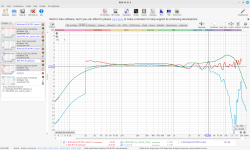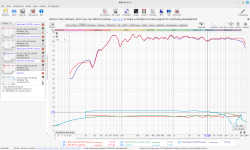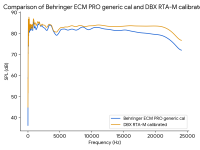The method is fine for low frequencies. But most omni mikes are quite flat from 20 Hz to 2-3KHz. Above that you get into a lot of messy acoustics that require free space and perfect superposition.
Measuring distortion would require low distortion on the speakers part, not guaranteed. However if you have two drivers in the box IM does not require low harmonic distortion. Just use non-harmonic drive to each driver.
Measuring distortion would require low distortion on the speakers part, not guaranteed. However if you have two drivers in the box IM does not require low harmonic distortion. Just use non-harmonic drive to each driver.
Demian is indeed spot on. If we have a high distortion driver, there will be little difference when taking measurements with different microphones...
Now, may I pick your brain further?
Suppose one has a pressure field microphone. eg. 1/2" random incidence 200V externally polarised mic -
can it be used to measure speakers... the way free-field omnidirectional microphone may be used?
In a pinch, can we use one of the correction files in your calibration charts? Or do we need to do our own substitution method...I know this is quick and dirty @trobbins but that's half the fun...
Now, may I pick your brain further?
Suppose one has a pressure field microphone. eg. 1/2" random incidence 200V externally polarised mic -
can it be used to measure speakers... the way free-field omnidirectional microphone may be used?
In a pinch, can we use one of the correction files in your calibration charts? Or do we need to do our own substitution method...I know this is quick and dirty @trobbins but that's half the fun...
if its an omni mike and a pressure mike (which means constanct amplitude in a small pressure vessel) then you can use the same correction curve to compensate for its rolloff. In some cases the pressure response mikes have better transient response because the self resonanace that boosts the HF is not as high Q.
I bought the new model, a behringer ecm pro microphone with a small capsule, on their page there is a generic calibration file, in the tests I did, I compared the 2 calibrated microphones, crossspectrum laboratories calibrated dbx rta-m and reference sonarworks, calibrated from the factory, I made the measurements with and without calibration, after an hour of perfect fixation at the distance height point, I took the measurements and entered them in chatgpt, I was not satisfied with the result, so I switched to google gemini which turned out to be more accurate, see screenshots. The important thing is to be patient with the AI and explain to it where it goes wrong, to ask him specific questions, this requires you to show it the printscreen and give it the measured data.The result will also contain the non-minimum phase effects from both measurements. If these effects are caused by the acoustics of the room and not the microphone, then the calibration file could introduce errors, this calibration is only for the room where it is made, it is not a universal one for all environments, if you want to make measurements outside or in an anechoic chamber, you have to make other calibrations.This calibration is done at the DIY amateur level.
The next pass for a perfect calibration I will do with an acoustic chamber and a midbass speaker in a pvc tube, example in Arta/software link: https://www.artalabs.hr/.../AN5-MicroMeasChamber-Rev4Eng.pdf
The next pass for a perfect calibration I will do with an acoustic chamber and a midbass speaker in a pvc tube, example in Arta/software link: https://www.artalabs.hr/.../AN5-MicroMeasChamber-Rev4Eng.pdf
Attachments
-
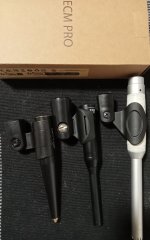 IMG20250226232843.jpg323.4 KB · Views: 120
IMG20250226232843.jpg323.4 KB · Views: 120 -
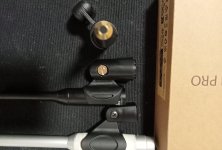 IMG20250226232918.jpg345.6 KB · Views: 111
IMG20250226232918.jpg345.6 KB · Views: 111 -
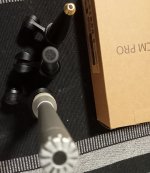 IMG20250226233023.jpg518.7 KB · Views: 122
IMG20250226233023.jpg518.7 KB · Views: 122 -
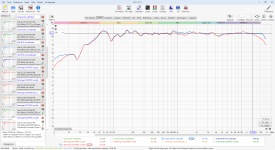 REW V5.31.3 2_26_2025 7_45_23 PM.png271.4 KB · Views: 123
REW V5.31.3 2_26_2025 7_45_23 PM.png271.4 KB · Views: 123 -
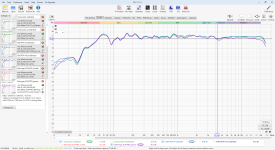 REW V5.31.3 2_26_2025 9_14_23 PM.png257.3 KB · Views: 118
REW V5.31.3 2_26_2025 9_14_23 PM.png257.3 KB · Views: 118 -
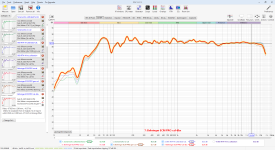 REW V5.31.3 2_26_2025 10_50_09 PM.png287 KB · Views: 118
REW V5.31.3 2_26_2025 10_50_09 PM.png287 KB · Views: 118 -
 REW V5.31.3 2_26_2025 10_50_20 PM.png284.2 KB · Views: 112
REW V5.31.3 2_26_2025 10_50_20 PM.png284.2 KB · Views: 112 -
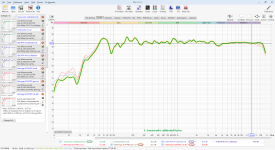 REW V5.31.3 2_26_2025 10_50_29 PM.png284.6 KB · Views: 115
REW V5.31.3 2_26_2025 10_50_29 PM.png284.6 KB · Views: 115 -
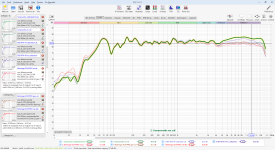 REW V5.31.3 2_26_2025 10_52_15 PM.png312.4 KB · Views: 98
REW V5.31.3 2_26_2025 10_52_15 PM.png312.4 KB · Views: 98 -
 REW V5.31.3 2_26_2025 10_52_02 PM.png313 KB · Views: 98
REW V5.31.3 2_26_2025 10_52_02 PM.png313 KB · Views: 98 -
 REW V5.31.3 2_26_2025 10_50_39 PM.png286.1 KB · Views: 98
REW V5.31.3 2_26_2025 10_50_39 PM.png286.1 KB · Views: 98 -
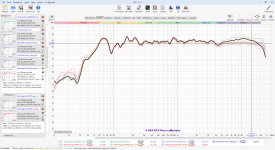 REW V5.31.3 2_26_2025 10_52_25 PM.png311.7 KB · Views: 112
REW V5.31.3 2_26_2025 10_52_25 PM.png311.7 KB · Views: 112
Good idea, I will make detailed measurements when I finish the measuring chamber, I will wait a few days when I can work outside. unfortunately I did not save the .mdat from the rew and it is difficult for me to fix each microphone again, perfectly in the exact place.Any differences between the mics on measured harmonic distortion?
An easy way to reproduce microphone positions is to use 2 laser(pointers) with some distance (e.g. low right of speaker and high left) and aim at the microphone membrane. They lasers only meet at one point in the room and when you put your mic there you can reproduce the position to about +-1mm.
@tktran303
All, just copying and pasting a post I made at MAC...
My Earthworks M23R is not working right so I have to send it to Sweetwater for several weeks. I sure hope they get it fixed, it was a pretty big deal for me to pull the trigger on that purchase.

I bought the new Behringer ECMPRO a few months ago but hadn't hooked it up.
I took a bunch of measurements 2 weeks ago before the EW started acting funny. Wanting to get this project done I will try to use the Behringer to wrap things up. My measurement rig is setup to be able to make pretty repeatable measurements. The ECMPRO does not have a calibration file and is supposed to measure out to 40kHz. I figured I would measure the speaker and make a calibration file to finish things up.
What the F@#!
Earthworks M23R $600 in blue
Behringer ECMPRO $40 in red - NO CALIBRATION FILE
I'll do more thorough testing and test distortion when I get the EW back, but just had to post this comparison.

All, just copying and pasting a post I made at MAC...
My Earthworks M23R is not working right so I have to send it to Sweetwater for several weeks. I sure hope they get it fixed, it was a pretty big deal for me to pull the trigger on that purchase.
I bought the new Behringer ECMPRO a few months ago but hadn't hooked it up.
I took a bunch of measurements 2 weeks ago before the EW started acting funny. Wanting to get this project done I will try to use the Behringer to wrap things up. My measurement rig is setup to be able to make pretty repeatable measurements. The ECMPRO does not have a calibration file and is supposed to measure out to 40kHz. I figured I would measure the speaker and make a calibration file to finish things up.
What the F@#!
Earthworks M23R $600 in blue
Behringer ECMPRO $40 in red - NO CALIBRATION FILE
I'll do more thorough testing and test distortion when I get the EW back, but just had to post this comparison.
If anything, I would first like to see a sample comparison of more than about 10 mics to check production quality and consistency.
https://www.hifi-selbstbau.de/index...0:1000-mikrofonkalibrierungen-eine-uebersicht
Only thing I have seen so far are just anecdotal comparisons, which are not useful at all.
https://www.hifi-selbstbau.de/index...0:1000-mikrofonkalibrierungen-eine-uebersicht
Only thing I have seen so far are just anecdotal comparisons, which are not useful at all.
I realized I do have distortion measurements of the drivers before the EW stopped working, so I can compare that, maybe this weekend.
@b_force - I agree to your point about seeing more, but anecdotal is not the right word. Anectodal: (of an account) not necessarily true or reliable, because based on personal accounts rather than facts or research. The measurements are facts/research, not a story, but I agree that one or two observations aren't statistically significant.
@b_force - I agree to your point about seeing more, but anecdotal is not the right word. Anectodal: (of an account) not necessarily true or reliable, because based on personal accounts rather than facts or research. The measurements are facts/research, not a story, but I agree that one or two observations aren't statistically significant.
Don't calibrate here, it's a mess, I compared a microphone bought by a friend with the cross spectrum labs calibration, see the differences here.If anything, I would first like to see a sample comparison of more than about 10 mics to check production quality and consistency.
https://www.hifi-selbstbau.de/index...0:1000-mikrofonkalibrierungen-eine-uebersicht
Only thing I have seen so far are just anecdotal comparisons, which are not useful at all.
You can’t expect a thorough calibration for that kind of money. Go to a serious lab and you pay twenty times as much. But does it really matter for DIY? Consistency is more important than exact level reference.
That being said, the guys at HS do this far more than any other, CS not included. So they offer some kind of reference…
That being said, the guys at HS do this far more than any other, CS not included. So they offer some kind of reference…
Anecdotal in this context is meant as a handful of experiences from just some people.The measurements are facts/research, not a story, but I agree that one or two observations aren't statistically significant.
"Based on casual observations or indications rather than rigorous or scientific analysis."
And thus therefor not objectively sound.one or two observations aren't statistically significant.
Meaning we simply can't draw any conclusions from it.
Sorry, don't have Facebook anymore, maybe you can share the results here?Don't calibrate here, it's a mess, I compared a microphone bought by a friend with the cross spectrum labs calibration, see the differences here.
Without account you can only see like 3 photos/pictures.
In general I don't know what you mean with "a mess".
...which are not useful at all.
Again, your point is valid but the way you are overstating it is simply wrong. Ex, Bayesian updating....
Meaning we simply can't draw any conclusions from it.
Since when is statistical insignificance considered wrong?Again, your point is valid but the way you are overstating it is simply wrong. Ex, Bayesian updating.
I’m sorry, but you simply can’t draw any objective conclusions from just a handful of measurements.
At least not in terms of technical reliability and/or quality/performance as well as production consistency.
The only valid conclusions we can make are specific to this particular example, and nothing more.
So, what point are you trying to make exactly?
Just a thought, it might be more helpful to ask for clarification before jumping to the conclusion that someone is "wrong".
It’s just not the most productive or pleasant way to communicate, especially in a technical discussion.
Last edited:
I posted objective data that should be useful to anyone considering purchasing the new Behringer ECMPRO.So, what point are you trying to make exactly?
You made some incorrect statements, seemingly confusing classical statistical inference vs an information set. For anyone actually considering buying this mic I wouldn't want then to be misled into thinking there has been no useful information at all.
There is no hypotheses, data or claims in this thread subject to levels of classical statistical inference.
- Home
- Design & Build
- Equipment & Tools
- Behringer Has a New Measurement Microphone
